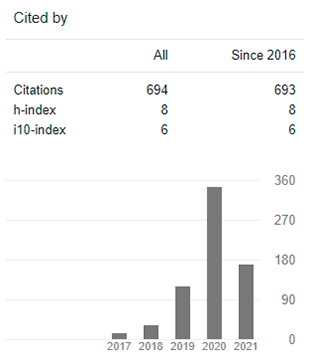Accessibility of Augmented Virtual Reality in Higher Education: Strategies, Challenges, and Benefits
Accesibilidad de la Realidad Virtual Aumentada en la Educación Universitaria: Estrategias, Desafíos y Beneficios
DOI:
https://doi.org/10.29394/Scientific.issn.2542-2987.2024.9.33.12.252-275Keywords:
virtual reality, augmented reality, higher education, accessibility, educational innovationAbstract
The implementation of Augmented Virtual Reality (AVR) in higher education faces various challenges affecting its accessibility and widespread adoption. This research analyzed strategies to improve AVR accessibility in university education through a qualitative systematic review of 50 articles published between 2020-2024, selected from academic databases including Scopus, Web of Science, Google Scholar, and PubMed. The methodology employed thematic coding and categorization to identify patterns and trends in the literature. Results revealed four main barriers: economic (equipment and infrastructure costs), technical (compatibility and maintenance), pedagogical (teacher training), and social (acceptance and perception). The most effective strategies include industry-university collaborations, sustainable infrastructure development, teacher professional development programs, and inclusion policies. The study concludes that successful AVR implementation requires a holistic approach integrating technological, pedagogical, and social aspects, prioritizing equitable access and long-term sustainability.
Downloads
References
Al Farsi, G., Yusof, A. bin M., Romli, A., Tawafak, R., Malik, S., … Rsuli, M. (2021a,b,c,d,e). A Review of Virtual Reality Applications in an Educational Domain. International Journal of Interactive Mobile Technologies (iJIM), 15(22), 99-110, e-ISSN: 1865-7923. Retrieved from: https://doi.org/10.3991/ijim.v15i22.25003
Barbosa, F., da Silva, C., Lima, N., Thomaz, S., & Viegas, J. (2023a,b,c,d). Virtual mobility in higher education in Brazil: factors of influence on satisfaction and continuity. Higher Education, Skills and Work-Based Learning, 13(6), 1354-1367, e-ISSN: 2042-3896. Retrieved from: https://doi.org/10.1108/heswbl-02-2023-0039
Bellido, R., Rejas, L., Cruzata-Martínez, A., & Sotomayor, M. (2022). The Use of Augmented Reality in Latin-American Engineering Education: A Scoping Review. Eurasia Journal of Mathematics, Science and Technology Education, 18(1), 1-20, e-ISSN: 1305-8223. Retrieved from: https://doi.org/10.29333/ejmste/11485
Cicek, I., Bernik, A., & Tomicic, I. (2021a,b,c,d,e,f). Student Thoughts on Virtual Reality in Higher Education - A Survey Questionnaire. Information, 12(4), 1-10, e-ISSN: 2078-2489. Retrieved from: https://doi.org/10.3390/info12040151
Correia, S., Godinho, R., & Aires, F. (2021a,b,c,d,e,f,g,h,i,j). Virtual reality and gamification in marketing higher education: a review and research agenda. Spanish Journal of Marketing - ESIC, 25(2), 179-215, e-ISSN: 2444-9695. Retrieved from: https://doi.org/10.1108/sjme-01-2020-0013
Gavin, N., Wei, S., Halim, D., Fow, K., Kang, H., & Yu, L. (2021a,b,c). Why Not More Virtual Reality in Higher Ed Teaching and Learning?. IEEE International Conference on Engineering, Technology & Education (TALE). ISBN: 978-1-6654-3687-8. United States: Institute of Electrical and Electronics Engineers.
González, S., Vivo, C., Juanes, J., & Palau, R. (2021). Virtual Reality in Higher Education: An Experience with Medical Students: Research into how Virtual Reality can be used as a powerful training tool for medicine students. Eighth International Conference on Technological Ecosystems for Enhancing Multiculturality. United States: ACM, Inc.
Huaraz, S., Andrade-Arenas, L., Delgado, A., & Huamaní, E. (2022). Augmented Reality: Prototype for the Teaching-Learning Process in Peru. International Journal of Advanced Computer Science and Applications, 13(1), 806-815, e-ISSN 2156-5570. Retrieved from: https://doi.org/10.14569/ijacsa.2022.0130194
Kim, J., Kim, K., & Kim, W. (2022). Impact of Immersive Virtual Reality Content Using 360-Degree Videos in Undergraduate Education. IEEE Transactions on Learning Technologies, 15(1), 137-149, e-ISSN: 1939-1382. Retrieved from: https://doi.org/10.1109/tlt.2022.3157250
Kumari, G., Knutzen, K., & Schuldt, J. (2023a,b). Exploring the Use of Social Virtual Reality Conferences in Higher Education. IEEE 2nd German Education Conference (GECon). ISBN: 979-8-3503-4813-2. United States: Institute of Electrical and Electronics Engineers.
Lavandera-Ponce, S., Pérez-Sánchez, L., Martín-Cuadrado, M., & Mora-Jaureguialde, B. (2023a,b). Límites y posibilidades en el proceso de virtualización tecno-pedagógica de universidades peruanas. RELATEC. Revista Latinoamericana de Tecnología Educativa, 22(2), 43-57, e-ISSN: 1695-288X. Recuperado de: https://doi.org/10.17398/1695-288x.22.2.43
Marques, A., & Frango, I. (2023). The State-of-the-Art of Research in the Production of Brazilian PhD and MSc Theses that Address the Use of Virtual Reality in Education. 18th Iberian Conference on Information Systems and Technologies (CISTI). ISBN: 978-989-33-4792-8. United States: Institute of Electrical and Electronics Engineers.
Rocha, F., Ruiz-Ramírez, J., George-Reyes, C., & Glasserman-Morales, L. (2022a,b). Evaluation of a Virtual Campus Adapted to Web-Based Virtual Reality Spaces: Assessments of Teachers and Students. Frontiers in Education, 7, 1-11, e-ISSN: 2504-284X. Retrieved from: https://doi.org/10.3389/feduc.2022.918125
Suyo-Vega, J., Meneses-La-Riva, M., Fernández, V., Alvarado-Suyo, S., Ocupa-Cabrera, H., Ocupa-Meneses, G., & Gago-Chávez, J. (2023a,b). Measurement of the level of knowledge of augmented reality in regular basic education teachers of the computer course in Metropolitan Lima after the first year of the health emergency caused by the COVID-19 virus. ISBN: 978-628-95207-4-3. United States: LACCEI.
Xiao, Y., & Watson, M. (2019). Guidance on conducting a systematic literature review. Journal of Planning Education and Research, 39(1), 93-112, e-ISSN: 0739-456X. Retrieved from: https://doi.org/10.1177/0739456X17723971
Published
How to Cite
Issue
Section
License
Copyright (c) 2024 INDTEC, C.A.

This work is licensed under a Creative Commons Attribution-NonCommercial-ShareAlike 4.0 International License.
The content of the journals of this site, are under a Creative Commons Attribution-Noncommercial-Share Alike 4.0 International License.













